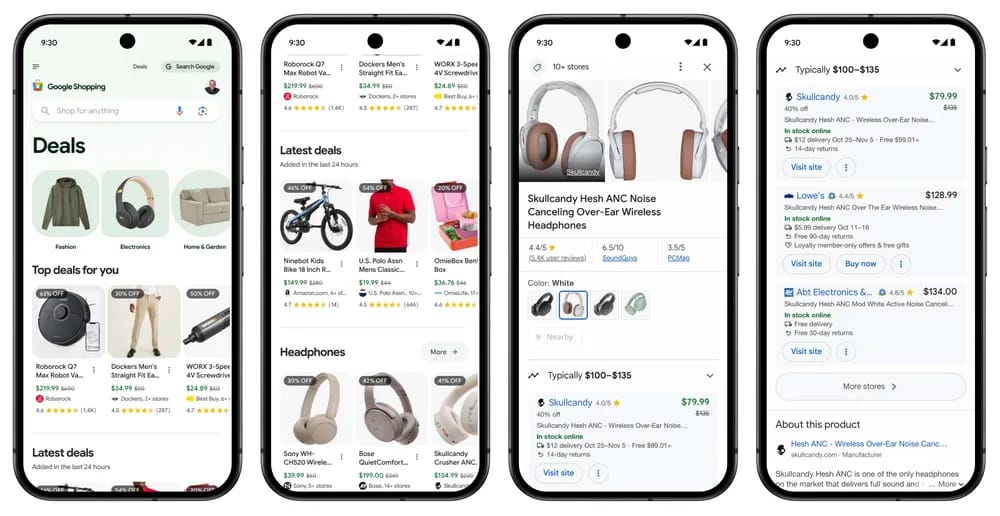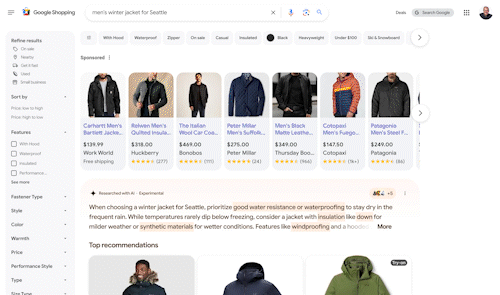- The Ad Insider
- Posts
- Google's Getting Smarter About Shopping
Google's Getting Smarter About Shopping
And why DTC and E-Commerce brands should care
In This Edition:
Google’s New AI Shopping Updates Change The E-Commerce Game (Yet Again)
Can You Trust Your Agency? Our “Agency Trust Framework” Will Help Answer That
Canada Post On Strike - What Does That Mean For DTC?
The Big News: Google Shopping's AI Glow-Up
Remember when "AI-powered shopping" meant getting recommended socks because you bought... socks?
Well, Google just dropped a bombshell that's about to change the game for everyone selling online.

Google just made a move that's going to reshape how people shop online. They've taken their massive catalog of 45 billion product listings (yes, billion with a B) and plugged it into Gemini, their most advanced AI model yet.
But this isn't just another AI update to ignore in all the hype. What makes it different?
Instead of just matching keywords to products, Google Shopping is now acting like a personal shopping assistant that actually understands context and intent.
Think about it this way - before, if someone searched for "winter jacket for Seattle," they'd get a list of jackets that happened to have those keywords.
Now? The AI analyzes Seattle's climate, understands what makes a good winter jacket for rainy weather, and provides tailored recommendations with explanations about why each jacket would (or wouldn't) work for Seattle's unique conditions.
Even better, the platform remembers what you've been researching and builds on that knowledge. So if someone's been looking at sustainable brands or comparing waterproof ratings, those preferences carry forward into future searches.
It's like having a sales associate who remembers every conversation they've ever had with a customer.
What's Actually Changing?
Here's where it gets juicy for DTC brands:

Personalized Shopping Feeds
Every shopper gets their own curated homepage (like TikTok, but for shopping)
Remembers past searches and preferences (no more starting from scratch!)
Serves up shoppable products AND videos (hello, content marketing opportunities!)
Smart Product Discovery Imagine this: Someone searches for "winter jacket for Seattle." Instead of just showing products, Google now provides:
A smart brief about what makes a good Seattle winter jacket
Curated product recommendations with explanations
Dynamic filters that actually make sense for the search
The Cherry on Top
Virtual try-ons powered by AI (bye-bye, returns?)
AR shopping tools (think furniture in your room before buying)
Built-in price comparison and tracking (transparency is king as value driven shoppers become the norm)
Why DTC Brands Should Care
Better Qualified Traffic When shoppers find you through this new AI-powered system, they're coming with more context and understanding. That means higher intent and (potentially) higher conversion rates.
Content Opportunity Google's pulling in content from across the web to inform purchases. If your brand has strong content marketing, you could show up in these AI briefs as an authority.
Price Intelligence With built-in price tracking and comparison, transparency is no longer optional. Time to get smart about your pricing strategy.
Value-Based Customer Targeting Here's the game-changer: Google's AI isn't just matching products to searches - it's understanding shopping behavior patterns. That means you can identify and target high-value customers based on their research depth, price point preferences, and purchase intent signals. Instead of casting a wide net, you can focus your ad spend on customers who are more likely to become repeat buyers or have higher average order values. Think of it as fishing where the big fish are actually biting.
What To Do About It
Ready to ride this wave? Here's your action plan:
Audit Your Product Data
Make sure your product feeds are detailed and accurate
Include high-quality images (they'll be used for AI try-ons)
Write rich product descriptions (AI loves good content)
Create Supporting Content
Build out buying guides
Create product comparison content
Share expert advice about your product category
Monitor Performance
Keep an eye on your Google Shopping metrics
Watch for changes in traffic patterns
Test different product titles and descriptions
The Bottom Line
This isn't just another update - it's Google fundamentally changing how people discover and shop for products online. And it's rolling out across the U.S. in the next few weeks. Some of you can see it at shopping.google.com right now!
The real winners will be brands that adapt quickly, provide rich product information, and understand how to work with (not against) the AI.

Can you REALLY Trust your agency?
Your marketing agency holds the keys to your growth. But who holds the keys to your data?
It's a tough question that sent our team on an industry-wide investigation. After witnessing hundreds of agency relationships first hand during our founder’s time at Facebook, and interviewing dozens of CMOs, we've uncovered the patterns that separate trustworthy partners from potential problems.
With Q1 fast approaching, now’s the perfect time to review your own agency relation ship and see if they pass the test.
🚩 The Trust Gap
What do we mean by “trust”?
Well, most agency relationships break down in predictable ways:
Mysterious "black box" reporting that never quite adds up
Data held hostage in agency-owned accounts
Strategic recommendations that feel more like upsells
Vanity metrics masquerading as business results
As our co-founder Uzair Chutani recently noted: "You'd be amazed how many brands don't actually own their ad accounts. Instead, their agency does. This is a massive red flag... it's like digital entrapment."
If you can’t see your own data, trust the reporting or understand the strategy, how can you truly be in control of your own business?
📊 What Excellence Looks Like
We needed a way to measure trust for our agency partners. Not just for them, but to hold ourselves accountable. So we created our Agency Trust Evaluation. This scoring system covers seven critical areas, but here are three that often surprise marketers:
Data & Control
Your accounts, your rules. Top agencies operate through client-owned platforms and provide crystal-clear documentation.
Performance Transparency
The best partners don't hide behind platform metrics. They welcome third-party validation and tie everything back to real business results.
Technical Excellence
Server-side tracking? First-party data strategy? These aren't just buzzwords – they're baseline requirements for modern paid media.
And that's just scratching the surface. From account management to platform expertise, our evaluation covers every angle of the agency-client relationship.
🎯 Take Action
Ready to take the plunge and see if your agency relationship holds up? It’s easy: We've packaged our findings into a straightforward framework that helps you:
Score your current agency partnership
Identify potential red flags before they become problems
Set clear expectations for performance and transparency
Make informed decisions about your marketing partnerships
⬇️ Get the Framework
Download our free Agency Trust Framework PDF. No email gate, no strings attached – just a practical tool for modern marketing leaders.
Canada Post’s Strike Continues - Here’s How To Weather The Storm
The nationwide strike is disrupting shipping across #Canada. Here's how leading brands are protecting their Q4 revenue:
✅ Update your site banners and email flows NOW. Proactive communication builds trust during delays. Encourage customers to take advantage of your free-shipping offers and guarantee their holiday gifts arrive on time!
✅ Leverage alternative carriers like FedEx and UPS. Consider temporary partnerships to maintain delivery promises, curb-side pick-up and other options to meet your customers needs. Shopify makes it easy to add new fulfilment options, so use them.
✅ Not affected? This is your moment! Highlight guaranteed delivery dates in your ads to capture market share from impacted competitors. Be the calm in the storm for your customers.
There's a silver lining to all this chaos: Smart brands can use this disruption to stress-test their contingency planning and come out stronger. Remember: Q5 is just getting started!
That’s a wrap for this week’s edition of Ad Insider! Did you get forwarded this newsletter? Subscribe here!
Have a question or a topic you’d like us to cover? Drop us a line!
Join the conversation on LinkedIn and follow us for real-time updates and more.